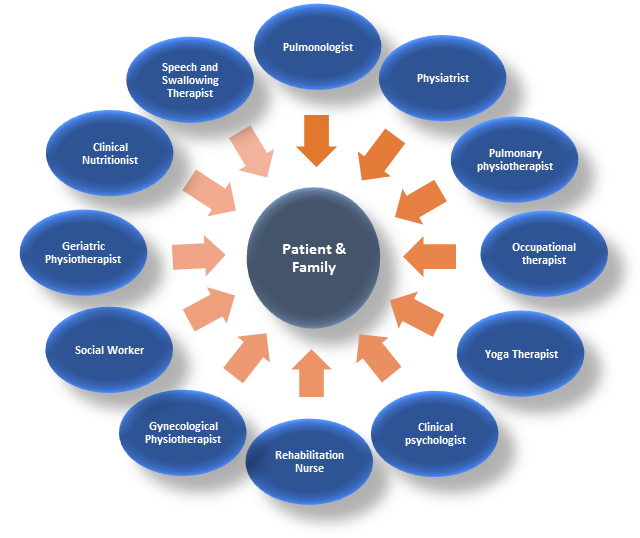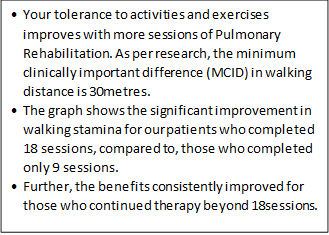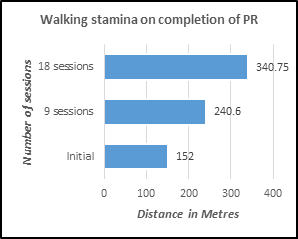May 15, 2020
Pulmonary Hypertension A Progressive Lung Disease
Pulmonary Hypertension (PH)
Pulmonary hypertension (PH) is a progressive lung disease. Arteries in the lungs of ...
Read More
What is Pulmonary Rehabilitation?
Pulmonary rehabilitation is an intervention for patients with chronic respiratory diseases who are symptomatic and often have decreased daily life activities. Our program is designed to help you meet the day-to-day challenges of living with chronic lung disease and help you return to the things you enjoy most.
Who can benefit?
Patients suffering from chronic lung conditions like
- Emphysema
- Asthma
- Chronic bronchitis
- Cystic fibrosis
- Interstitial lung disease
- Pre- and post-lung transplant surgery
- Any lung conditions that could lead to decreased quality of life
Benefits of Pulmonary Rehabilitation
- Reduction in dyspnea and improved lung capacity
- Increase in muscle strength and endurance (peripheral and respiratory)
- Increase in overall exercise tolerance
- Improved health related quality of life
- Increased independence in activities of daily living
- Education for coping strategies
- Promotes and reinforces long term commitment to exercise and lifestyle modification
Any clinical expert like Pulmonologist, Physiatrist, Cardiologist, Rheumatologist, General Practitioners, Internal Medicine Physician, Emergency Medicine doctor, Cardiopulmonary Physiotherapist etc. would be able to refer you for a Pulmonary Rehabilitation programme. You may also directly enroll yourself for the comprehensive PR program with us.

Role of Pulmonologist
Pulmonologist is responsible for overall medical direction of the program. Pulmonologist identifies the comorbidities that might necessitate modifications in the patient's individualized program.
Role of Physiatrist
Physiatrist is a physician specialized in Physical Medicine and Rehabilitation specially trained in rehabilitation of acute and chronic lung conditions. He works with Pulmonologist and other rehabilitation team members to work with you / patient to identify your rehabilitation needs to achieve goals.
Role of cardiopulmonary physiotherapist
- Increase exercise and daily activity tolerance
- Establish independence in daily activities
- Improve lung function, chest clearance and prevent accumulation of secretions
- Strengthen muscles for better function
Role of Geriatric physiotherapist
- Assess the fall risk
- Evaluate caregiver burden
- Carry out geriatric fitness assessment
Role of occupational therapist
- Facilitate independence in activities of daily living
- Improve the endurance level
- Reduce fatigue during day to day activities
Role of clinical psychologist
- Support patients adaptation to the respiratory disease
- Minimize distress and disability associated with respiratory diseases
- Facilitate smoking cessation
- Detect and manage acute exacerbations
Role of Gynaec Physiotherapist
- Reduce symptoms of urine leakage during coughing or sneezing
- Strengthen pelvic floor muscles
- Prevent floppy abdomen
- Retrain bladder and bowel
Role of speech, language and swallowing therapist
- Improve voice quality
- Increase respiratory support for speech
- Facilitate respiratory swallowing coordination
Role of Clinical Nutritionist
- Deal with the knowledge of food and nutrition and other related disciplines like physiology, biochemistry to promote the health.
- Maintain optimal nutritional status that can delay progression of the disease
- Assess for nutritional deficiencies / Nutritional risk can be identified through the screening and assessment of the patients
- Provides dietary advice to increase the overall well being
Role of Yoga therapist
- Guides proper physical postures and breathing practices
- A better alignment in mind breath body connection
- Relaxation techniques to address the distress in pulmonary conditions
The program includes 18 sessions which will include a holistic intervention approach involving the Pulmonary Rehabilitation team. Once the program is over, the patient would be advised to come for a follow up assessment every 3 months.


A unique support group which focuses on encouraging and motivating our patients with pulmonary disorders to overcome the difficulties that they are facing. It’s a get together of patients in every quarterly, where they share experiences and suggestions to each other. We connect patients and caretakers with various clinical experts, respiratory assistive device providers and home modification experts. It is the best opportunity to socialize and get inspired from the people who are successfully managing their chronic lung conditions and leading a meaningful life.
- First of its kind structured program in India
- Evidence based protocol
- Multidisciplinary team of Specialists
- Comprehensive Care
- Quantified patient progress
- Customized protocol
- Home assessment and modification
- Continued guidance for managing at home
- Patient centric approach to improve overall quality of life
- Overall Quality of Life
- Overall life expectancy
- Breathing control
- Walking Stamina
- Performance of daily activities
- Satisfaction in resuming daily activities
- Emotional well being
- Social functioning
Breathing back to life
We have found significant reduction in respiratory disability, oxygen dependency, caretaker burden and frequency of hospitalizations.
FAQ
What Is Pulmonary Hypertension (PH)?
Pulmonary hypertension is a type of high blood pressure that affects the arteries of the lungs and the right side of the heart. The blood vessels in the lungs are narrowed, blocked or destroyed.
Who gets Pulmonary Hypertension?
There are a few risk factors that can cause some people more likely to have pulmonary hypertension, but anyone can get it. It affects children and adults, men and women and people of all races and ethnic backgrounds. PH can exist alone or be associated with other conditions such as connective tissue disorders (scleroderma, lupus and others), heart disease, HIV and COPD.
What are the symptoms of Pulmonary Hypertension?
The symptoms of pulmonary hypertension develop slowly which is why it is difficult to notice them for months or even years. The symptoms include shortness of breath, fatigue, dizziness, chest pain or pressure, swelling in ankles or foot, bluish colour to your lips, racing pulse, etc.
What are the types of Pulmonary Hypertension?
Pulmonary hypertension is divided into five categories, based on the cause.
Pulmonary arterial hypertension (PAH)
Pulmonary hypertension caused by left-sided heart disease
Pulmonary hypertension caused by lung disease
Pulmonary hypertension caused by chronic blood clots
Pulmonary hypertension triggered by other health conditions
How Is Pulmonary Hypertension Diagnosed?
It is difficult to diagnose pulmonary hypertension in the routine physical exam as the sign and symptoms are similar to other heart and lung conditions. To diagnose PH the doctor will order a few tests which may include a blood test, chest X-ray, ECG, echocardiogram, CT scan, MRI, pulmonary function test, Ventilation/perfusion, etc.
How is Pulmonary Hypertension treated?
There is no cure for pulmonary hypertension, but there are several treatment methods that can manage the condition and slow the progress of PH.
Can lifestyle changes help with Pulmonary hypertension?
Yes, lifestyle changes can help in improving the condition and slow down the symptoms. Follow these tips:
Get plenty of rest
Avoid smoking
Avoid birth control pills
Eat healthily and manage your weight
Don’t travel to high altitudes
Who treats Pulmonary Hypertension?
Pulmonary hypertension is treated by a cardiologist, cardiac surgeon and pulmonologist. It can be managed by medications, therapy, but if medicines don't work, surgery is required.